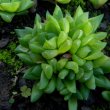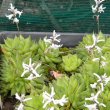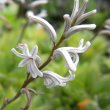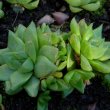| Botanical Name |
|
| Family |
Asphodelaceae - The Asphodel family.
|
| Pronunciation |
ha-WORTH-ee-a sim-BYE-for-miss |
| Common Name(s) |
English: Cathedral window haworthia
|
| Plant Group |
- Ground Cover A plant with a low-growing, spreading habit, grown specifically to cover the ground.
- Succulent A plant having fleshy stems or leaves often adapted to dry conditions.
|
| Plant Size |
- Very Small
| Tree | 3m to 4m |
| Shrub | 25cm to 50cm |
| Perennial/ground cover | Up to 10cm |
| Bulb | 10cm to 20cm |
| Succulent | Up to 5cm |
|
| Position |
- Canopy Shade Canopy shade is found below closely grown trees where some light filters through. Ideal for the protection of herbaceous plants.
- Light or Dappled Shade Found below trees with sparse, open foliage. Ideal for the protection of herbaceous plants.
- Partial Shade The area is in shade for part of the day and in full sun for part of the day.
- Sun The area is in full sun for all or most of the day, all year round.
|
| General Information |
- Drought Tolerance: Moderate The plant is moderately adapted to arid conditions and can survive short periods of drought and high temperatures without extra water.
- Evergreen Plants that have leaves all year round.
- Frost: Tender A plant that will not survive any frost or low winter temperatures.
- Water Moderate These plants will need some extra watering compared to water-wise plants. Plant them together, in at least some shade and in a convenient proximity to the house so that grey water can be utilised during times of drought.
|
| Specific Information |
Haworthias belong to the aloe family. They tend to get lost in the garden so consider keeping them close to each other until they have formed clumps, in pockets in a rock garden or a special area set aside for very small plants. In the veld Haworthia cymbiformis almost buries itself in the ground, with only the tips of the leaves showing. With its soft, near-translucent leaves it needs protection from the hot rays of the midday sun.
In a pot, this Haworthia will set off-shoots all along the outer rim of the plant and soon make a hemispherical clump.
|
| Ad Break |
|
| Flowers |
| Description |
Small, tubular, on long, thin stems.
|
| Season |
- Spring Plants will seldom bloom for the entire season as given in the list, but should flower during a period within these parameters.
|
| Colour |
|
| Growth Rate |
- Fast Specifying growth rate can be very misleading as there is considerable variation of growth rate depending on type and species of plant, available water, supplementary feeding, mulching and general care, as well as the plants suitability and adaptability to the garden environment.
|
| Plant Uses |
- Container Trees, shrubs and ornamental species that can adapt to growing in a restricted environment.
- Edging A low growing plant that provides softness or definition to the edges of a bed or walkway.
- Filler Either a fast growing tree or shrub used temporarily to fill in an area while the permanent plants grow to a desired size, or a plant used to fill gaps in borders or beds.
- Mass Planting Plants useful for filling a large area with just one or a few kinds of plants spaced close together. Creates a bold, dramatic effect and to reduces maintenance.
- Pot Plant A plant that needs a protected environment on a patio or indoors.
- Rock Garden An area constructed of larger rocks, arranged naturally, to emphasise the use of stones as a main element. Generally plants used do not need a lot of care.
- Stabilize Banks Plant is used to prevent soil erosion because their roots will form a mat that stabilizes the soil and keeps it from washing away in heavy rains.
- Water Features These plants may have dramatic, lush foliage or graceful form. They do not shed excessive leaves and do not have invasive root systems.
- Wild Garden An indigenous garden planted for the benefit of wildlife and birds. Provides food, water, a variety of mini-biomes and no poisonous chemicals are used.
|
| Distribution and Habitat |
Port Elizabeth to East London in the Eastern Cape Province, on rocky slopes along rivers and streams
|
| Planting Suggestions |
Plant in any well-drained garden soil in a position where the plants will get some sun during the day to prevent them from becoming bloated. Haworthia thrive on a little more water than most other succulents.
There are many different types of Haworthia and a combination of them in a shallow container is always an attraction.
|
| Medicinal Uses |
|
| Ad Break |
|









Discuss this plant
Share knowledge, ask a question or give an experience.